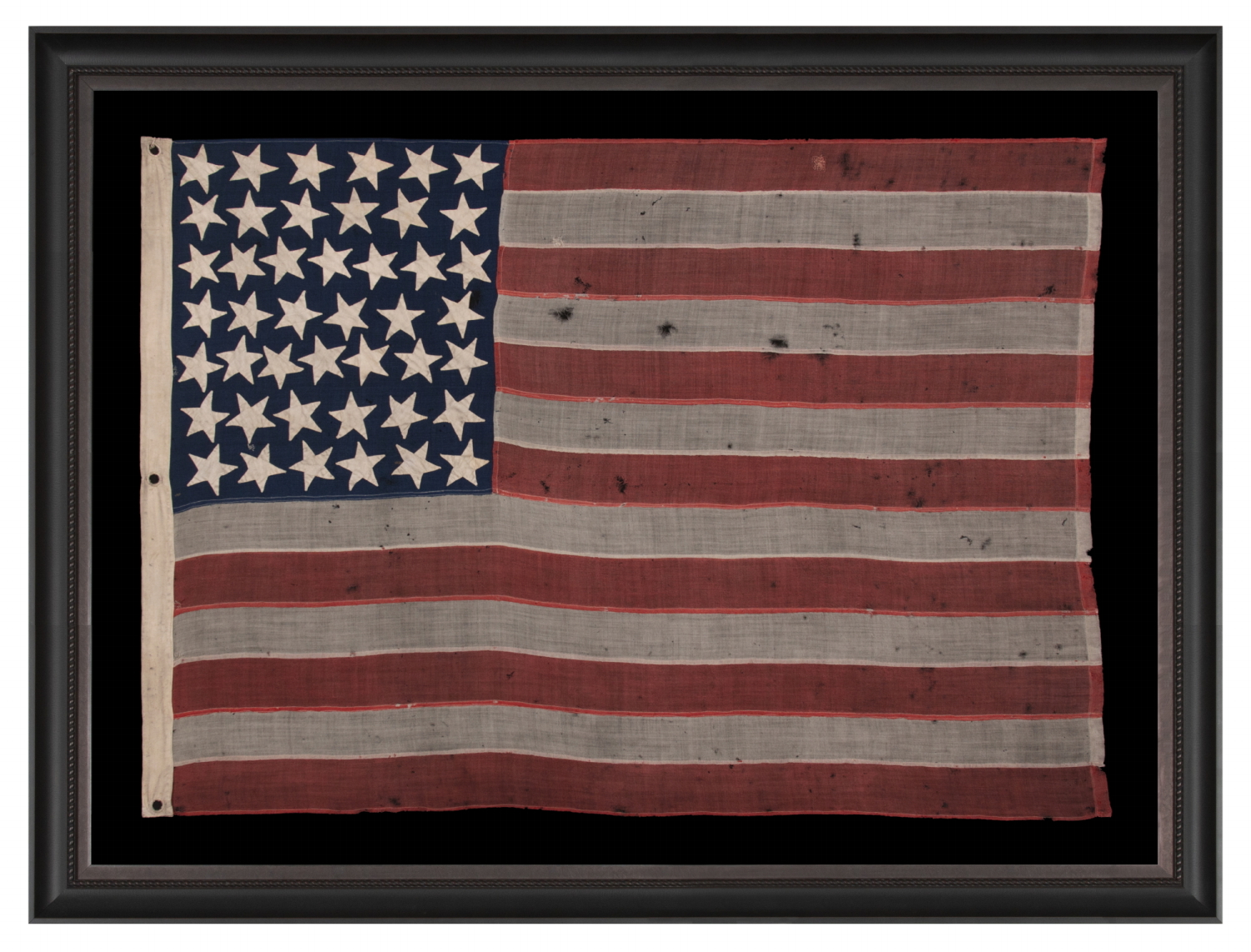


| 44 STAR ANTIQUE AMERICAN FLAG, WITH GREAT FOLK CHARACTERISTICS THAT INCLUDES A NARROW, VERTICALLY-ORIENTED CANTON AND ESPECIALLY LARGE STARS, ORIENTED IN ALL DIRECTIONS, THE ARMS OF WHICH ARE NECESSARILY INTERTWINED; WYOMING STATEHOOD, 1890-1896 |
|
| Web ID: | 44j-818 |
| Available: | In Stock |
| Frame Size (H x L): | Approx. 53.5" x 70.25" |
| Flag Size (H x L): | 41.5" x 58.25" |
| Description: | |
| 44 star American national flag with a presentation of stars that bears strong folk qualities. This consists of a canton that is actually taller than it is wide, with 7 rows of stars, in counts of 6-6-7-6-7-6-6. Although this is a very unusual layout, any notion of its interest, academically, is rather outweighed by the graphics that result from other attributes. Chief among these is the size of the stars with respect to their assigned space, and how they are positioned on their vertical axis. Inappropriately small, the tall canton is jam-packed with stars so large that their arms, oriented in all directions, intertwine by way of necessity. The stars of the flag are made of cotton, hand-sewn, and double-appliquéd (applied to both sides). The stripes and canton are made of wool bunting that has been joined with treadle stitching. There is a linen or cotton binding along the hoist, applied in the same manner, with three, hand-sewn, whip-stitched grommets. The sewing of these was accomplished around metal rings, added for reinforcement, which, while not unheard of, is seldom encountered. Also note that the overall proportions of the flag are somewhat more square than they are on many flags. This makes sense, with the vertically-oriented canton, as military battle flags often shared these traits. The nearer-to square a flag was, moving away from the normal, horizontal form, the larger it could be without dragging on the ground, and the higher it could be carried. Visibility was very important, as was weight. Longer flags are much more difficult to maneuver. While the flag has no specific, known history, it is very likely that this flag was meant to be hand-carried, perhaps in some military capacity. Wyoming was admitted as the 44th state on July 10th, 1890. Although the 44 star count would not become official until July 4th of the following year, in 1891, flag makers would have begun to add a 44th star immediately, if not even beforehand, in hopeful anticipation of its forthcoming statehood. This became common practice among flag-makers during the latter 19th century, reflecting both the nation’s push for westward expansion and a desire not to be one step behind their competitors. Most did not want to be producing 43 star flags, for example, when their competitors were selling 44’s. Though the 44 star count remained official until July 3rd, 1896, it would have generally fallen out of use when Utah gained statehood on January 4th of that year. While there remained no official star configuration until 1912, as time advanced through the 19th century and into the 20th, flags became more and more alike, and less graphically compelling, with fewer homemade traits of a folk art nature. Beyond its assets in that regard, one of this particular flag’s best characteristics is its small size among its pieced-and-sewn counterparts, most of which were considerably larger. Smaller flags are not only more rare, but easier to frame and display in an indoor setting. The combination of these facts fuels the demand for small sewn flags, especially those with hand-sewn stars and strong folk attributes, like this one. Mounting: The textile was mounted and framed within our own conservation department, which is led by expert staff. We take great care in the mounting and preservation of flags and have framed thousands of examples. The mount was placed in a deep, cove-shaped molding with a very dark brown surface, nearly black, and a rope-style inner lip, to which a flat profile molding, with a finish like old gunmetal, was added as a liner. The glazing is U.V. Protective acrylic (Plexiglas). Condition: There is minor mothing throughout, accompanied by modest to moderate occurrences of the same in the 1st through the 5th stripes, as well as the 6th. There are two instances of hand-sewn darning in the canton, as a means of repair to small holes, plus one each in the 1st and 2nd stripes. There is very minor soiling and oxidation in the white fabrics. Many of my clients prefer early flags to show their age and history of use. |
|
| Video: | |
| Collector Level: | Advanced Collectors and the Person with Everything |
| Flag Type: | Sewn flag |
| Star Count: | 44 |
| Earliest Date of Origin: | 1890 |
| Latest Date of Origin: | 1896 |
| State/Affiliation: | Wyoming |
| War Association: | 1866-1890 Indian Wars |
| Price: | Please call (717) 676-0545 or (717) 502-1281 |
| E-mail: | info@jeffbridgman.com |
 |
|